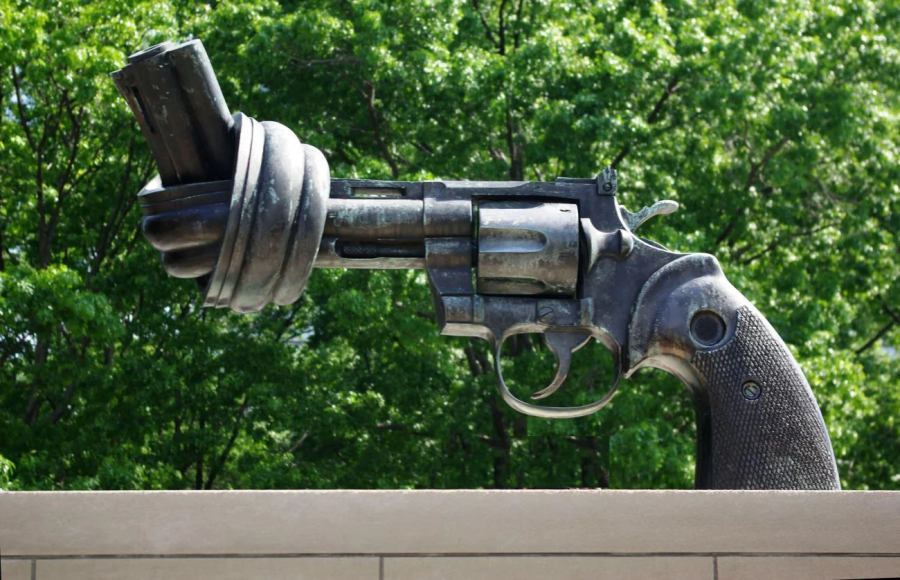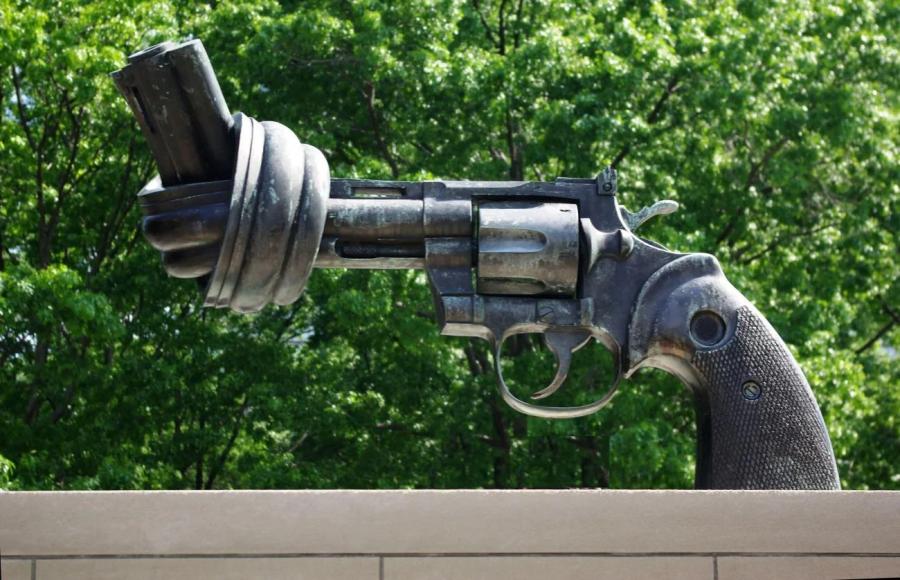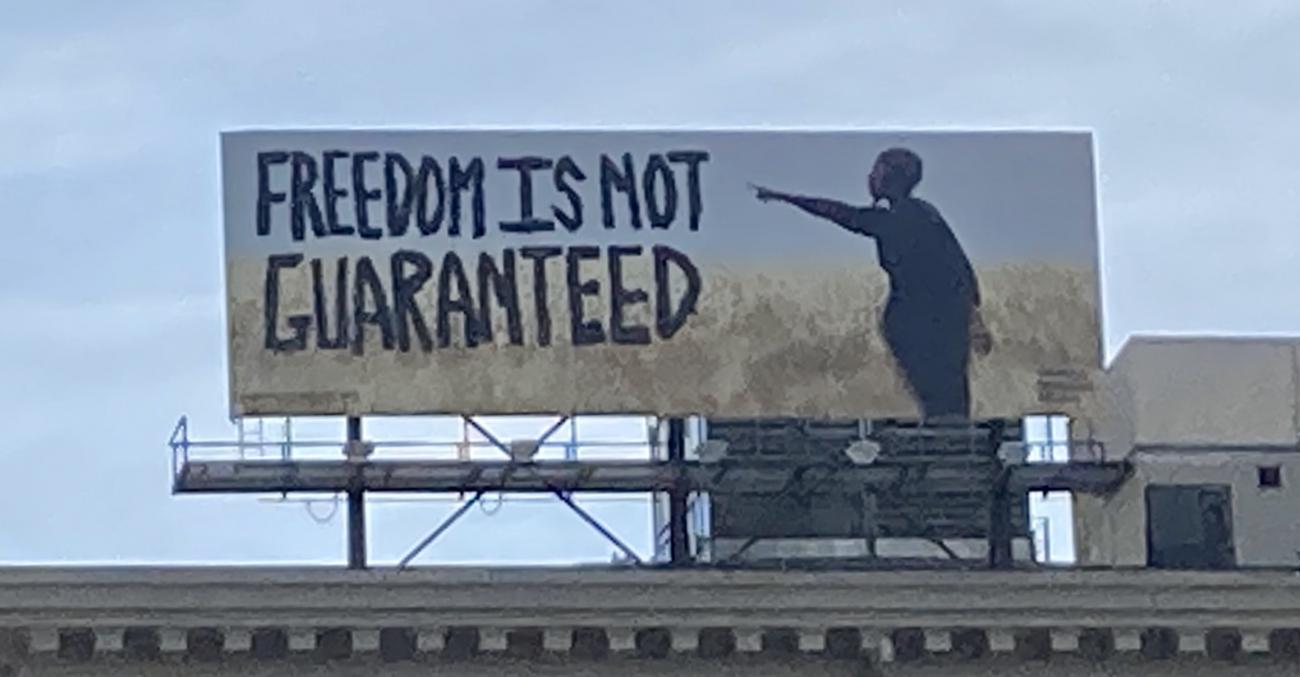
By Phoebe Farris
Curator Dagmar Painter’s blog, Painterprojects.com, features artists whose visual art reflects the various themes. Her blog emphasizes the healing aspects of art to social justice art activism. One of Painter's links, “Artists Speak: Visual Poetry”, features the poem, “The Delight Song of Tsoai-talee” by Kiowa writer M. Scott Momaday, a Pulitzer Prize winner. Dagmar states, “poetry is to painting as painting is to poetry.” In this virtual exhibition, artists were asked to submit visual images that referenced the “beauty of the word images” expressed in Momaday’s poem. The Delight Song of Tsoai-talee” was originally published in Presence of the Sun: Stories and Poems, 1961-1991 by St. Martin’s Press in 1992. Artists were asked to bring their own personal histories and experiences to their interpretations of Momaday’s poem.
Several artists who had previously collaborated with Painter and co-curator Jennifer Heath in their 2013-2018 traveling exhibition, The Map is Not the Territory: Parallel Paths, Palestinians, Native Americans, and Irish, felt a connection to Momaday’s poem and submitted paintings, photographs, and prints. The phrase, “The Map is Not the Territory,” created by philosopher and scientist Alfred Korzybski, deals with the concept that territories people inhabited, existed in historically, currently inhabit with restrictions, and/or can only symbolically inhabit are not synonymous with the maps and nation/ state boundaries and political desires drawn by their colonizers. The traveling exhibition looked at relationships and commonalities in Palestinian, Native American, and Irish experiences of invasion, occupation, and colonization, through wall texts, catalog essays, and visual art the sufferings of the three populations. The exhibition covers their encounters with one another historically and in contemporary times. Three Palestinian artists, Najib Joe Hakim, Sam Husseini, and Najat El-Khairy are highlighted in this article with their written and visual interpretations of a poem composed by a Native American writer. Each artist explores and expresses their own Indigenous experiences as Palestinians living away from their historical homeland and how their lives parallel some of the themes reflected in various lines by an Indigenous writer from the United States, M. Scott Momaday (Kiowa).
Najib Joe Hakim
Najib Joe Hakim, a freelance photographer and photojournalist based in San Francisco, California, has published in national and international magazines and newspapers. He comes from a family of Palestinian refugees who are npw United States citizens. Hakim posted two black and white photographs in response to Momaday’s poem. He said he found the imagery in the poem, “The Delight Song of Tsoai”, to be “as expansive as the sky and as minute as a snowflake. It is full of promise like the first breath of the morning air or the first thoughts of a newborn.”
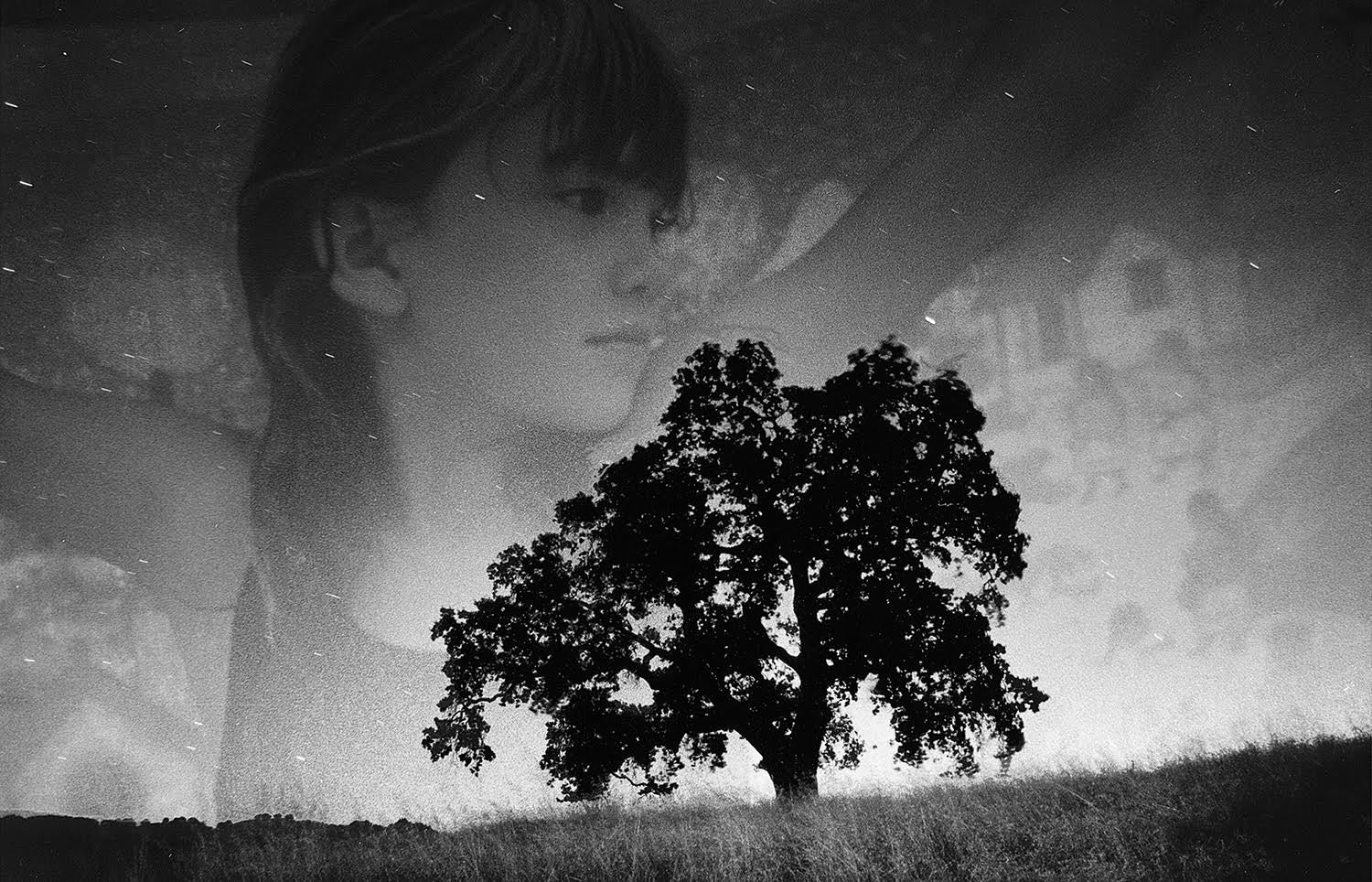
“Mysteries of the Night” by Najib Joe Hakim.
The photograph, “Mysteries of the Night”, 16x20”, centers around a young girl with her arms upraised, filling up almost the entire space. With a wistful face in profile, pale gray tones, and soft focus, the girl dominates the scene. Behind her is a small quaint village scene with houses slanted at a downward angle and small figures walking down the road. A dark leafy tree, center bottom is in front of the young girl. The village scene seems like an image from another era whereas the young girl looks very contemporary.
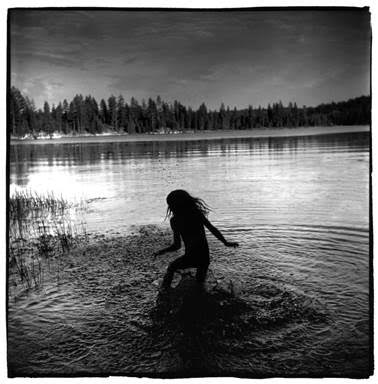
“Emergence” by Najib Joe Hakim.
“Emergence”, 8x8”, uses the same model, this time playing in the shallow waters that are part of a larger body of water, perhaps a lake or ocean. The other side of the body of water has trees along a stretch of land. The female figure is black and shadow like and her surroundings are gray tones. Whether graphic black and small in size or pale gray but large, the young model in both photos is the dominant focus, drawing us into scenes that could be anywhere--a young girl seemingly adapting and at peace in any environment.
In a 2014 exhibition that took place in California titled, Home Away from Home, Najib Joe Hakim explored how Palestinians maintain ties to their homeland while living in a country that opposes their political beliefs regarding a Palestinian state. In a catalog essay for the exhibition The Map is Not the Territory, Hakim stated, “My land follows me wherever I go. The daily suffering of my people is a constant reminder of its existence and struggle.”
Sam Husseini
The title of Husseini’s submitted painting, I am an eagle playing with the wind, is a line from M. Scott Momaday’s poem. The 45x19” acrylic painting is described as flora and fauna visibly absent. His abstract diptych with natural organic forms is painted predominantly in shades of purple and pale orange. The layered colors and floating imagery could be interpreted as feathers, leaves, or birds’ wings.
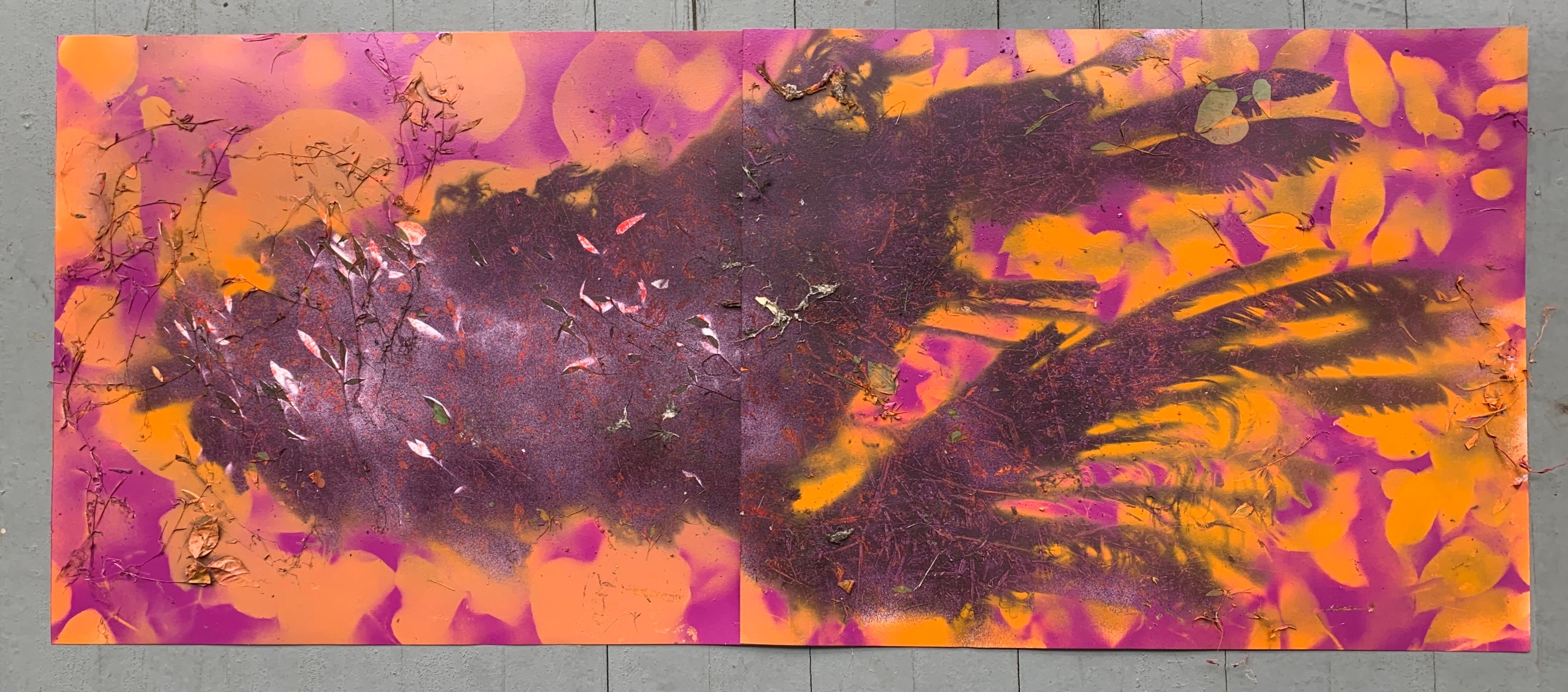
The Eagle by Sam Husseini.
Another painting, The Eagle, has similar coloring with an emphasis on purple, lavender and pale orange. The eagle is an important symbol for almost all Native American Tribes in the United States. In many Tribes, the eagle is considered a messenger that sends or brings prayers to the Great Spirit or to the sky above. Husseini’s portrayal of the eagle is also in abstract form.
In another of Dagmar Painter’s online exhibitions, Husseini describes his works as, “rooted in the wider notion of what our relationship should be with Nature. Our hubris needs to be tempered, our desire to control and conquer Nature needs to be checked. Failing to do so does tremendous damage to the outside world and to our inner lives.”
While many artists who focus on social justice themes dealing with issues of race, war, the environment etc. feel compelled to produce works that are more realistic, Sam Husseini shows viewers that abstract imagery can be just as powerful, especially in highlighting Nature and the human desire to control and conquer it.
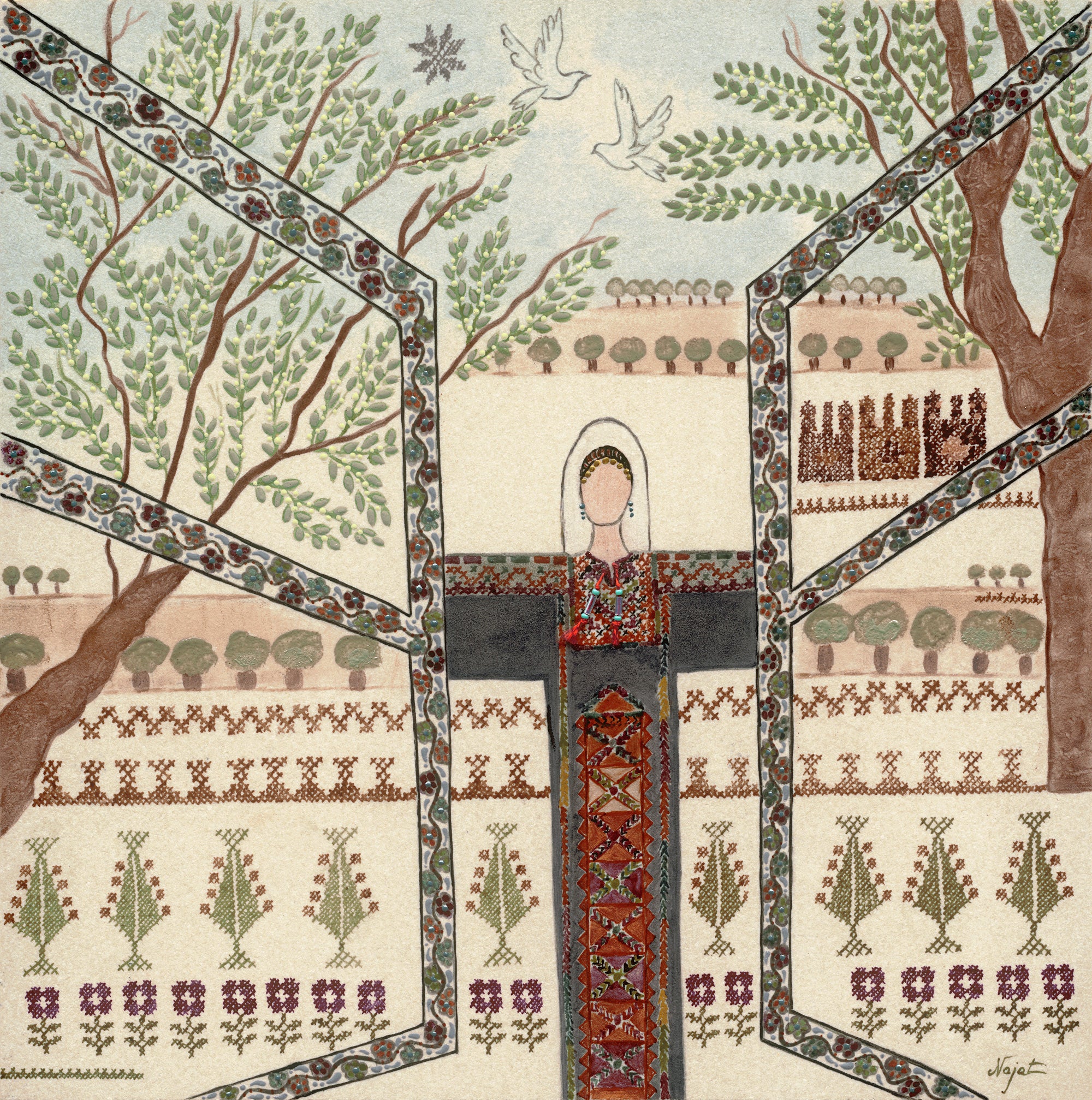
Liberation by Najat El-Khairy.
Najat El-Khairy
Palestinian artist Najat El-Khairy selected her “Catharsis" series of three hand painted on porcelain works to represent her interpretation and connection to M. Scott Momaday’s poem and included her detailed thoughts on the relationship between her works, the poem, and Native American/Palestinian commonalities, stating that she immediately related “The Delight Song of Tsoai-tale” to her “Catharsis” piece because of the similarities of some of the words in the poem and her own work. “Elements such as softness, strength, beauty, symbolism, harmony with nature, connection with everything around, relation to the earth, the assertiveness of being alive and in existence. These elements translate to my art work: a cathartic moment occurred...strength and energy transformed her to become the Olive Tree symbol of Resilience, resistance and determination, facing all sorts of injustices, entrenching deeply her roots into her land, proudly holding her history, culture and heritage on her shoulders, her unalienable Rights for Liberty.”
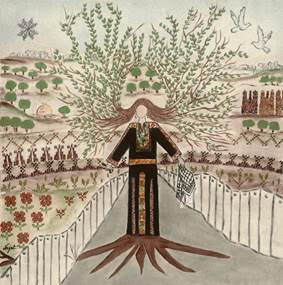
Catharsis by Najat El-Khairy.
Catharsis, 12x12”, hand painted porcelain features a tall thin woman in a perspective triangular shaped road wearing traditional Palestinian clothing with embroidery on the sleeves, the neckline, waist, and on long panels from the hips to the ground. Her legs or feet are tree roots or branches firmly planted on the ground. The woman has flowing hair and wears earrings but her facial features are omitted. The background is a large rural environment of plants, shrubbery, and produce with a star and doves in the sky. For El-Khairy the star in the sky resonates with a line from the poem, “I am the farthest star.” For her painting she created the line, “I am the star of Bethlehem.”
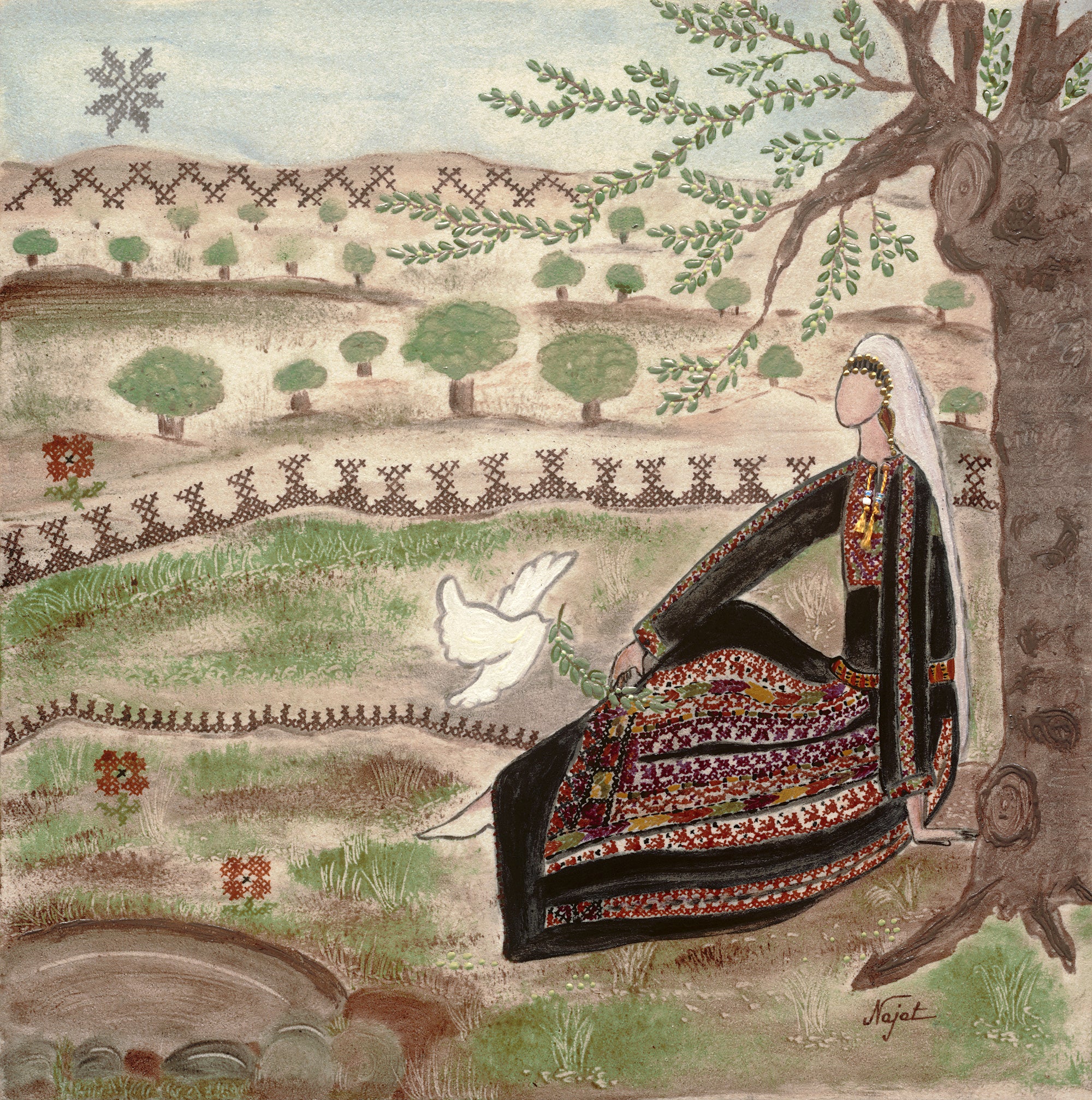
The Dove, another painting from the series, “represents the Palestinian village woman under the olive tree in an olive field, of desperately wondering about her destiny, her past and future ...when a dove gracefully deposits an olive branch into her hand, inviting hope, and promising peace,” according to El-Khairy.
Najat El-Khairy studied painting, music, ballet, embroidery, stained glass, pottery, silk painting, and English literature at French private schools in Cairo, Egypt and King Saud University in Riyadh, Saudi Arabia where she earned a BA in English Literature. After moving to Canada in 1988 she began collecting traditional vintage village dresses, often exhibiting them which ultimately led to her medium of Palestinian art painted and pressed on porcelain tiles. Merging the two art forms is El-Khairy’s way to help protect and preserve on a hard lasting surface, the cultural heritage of Palestinian art.
Concerning the similarities between Palestinians and Native Americans, Najat said, “Erasing and eradicating the Native American and Palestinian people go hand in hand with the crimes against humanity. Massacring and killing both peoples in every form is similar and can be summarized in one word: Ethnic Cleansing. Genocide is another word to describe the savagery and barbarity those two peoples went through and are still going on to this day.
“Cultural appropriation, falsification of history, is one of the crimes against the Indigenous people of the land. Both the Native Americans and the Palestinians fight to preserve their history, stories, habits, folkloric songs and dance, food, rich heritage and culture in all its forms, which have been tampered with and stolen. The occupiers ultimate goals are to erase any signs or the crimes they commit against the people of the land: by dominating them, imposing new teachings and new ways of life, and what they cannot erase, they appropriate with audacity.
“Both people fight to this day for freedom, fight for their dream to be living in peace on their own land. Both people were deprived from their lives, homes, and livelihoods. Both people seek fairness and justice.”
Echoing Momaday’s line, “I stand in good relation to the earth”, Najat El-Khairy created the line, “I stand proudly with my roots entrenched deeply into the earth.”
________
Interview With Dagmar Painter: The Exhibition Curator and Blog Designer
Phoebe Farris: Until a few years ago most of your career positions involving art such as curator, author, professor, and gallery director centered on Arab, Middle Eastern, and Islamic cultures. As the founder and curator of the Jerusalem Fund Gallery Al-Quds in Washington, DC you featured contemporary artists whose works centered on issues of the Arab and Islamic worlds, with a special emphasis on artists of Palestinian heritage, the Indigenous people of the areas now defined as Israel, the West Bank, and the Gaza Strip. Then from 2013-2018 you were the co-curator of the traveling exhibition, The Map is Not the Territory, Parallel Paths: Palestinians, Native Americans, Irish. How did you become interested in Native American art and culture? What common threads do you find in social justice themed art and culture?
Dagmar Painter: The Map exhibition exhibition was a serendipitous intersection in my search for ways to foreground the Palestinian struggle for justice within the context of other “real world” experiences perhaps not realized by non Palestinian audiences. It was my good fortune to meet Jennifer Heath, who originated the Map concept and asked me to co curate and bring Palestinian voices into the mix. I was already aware of connections between Palestinians and Irish social justice issues, so the addition of Indigenous people’s current and historical struggles added the third crucial leg to balance the stool.
PF: After a very successful career at Jerusalem Fund Gallery you retired from there and established your current blog that focuses on the healing aspects of the arts. Your blog includes poetry and visual art that complement each other. A recent entry includes the poem, “The Delight Song of Tsoai-talee” by M. Scott Momaday originally published in “ Presence of the Sun: Stories and Poems 1961-1991, St. Martin’s Press, 1992. Why did you select Momaday’s poem for visual artists to respond to?
DP: In my role as curator at Gallery Al Quds, I had previously held art challenges involving artists’ responses to poetry, such as a poem entitled, “And We Have Countries” by Mahmoud Darwish. For these challenges I invited artists from diverse backgrounds, going beyond those of Arab heritage, to create a universalist, intersectional experience. The poem hinged on the visual aspects of the poem, its’ ability to be interpreted in a tactile way, in painting or sculpture or photography. Every line of Momaday’s poem, which I discovered online during National Poetry Month, created an image in my mind which I was eager to see interpreted by diverse artists.
PF: So far mainly Palestinian and other Middle Eastern artists have submitted art works for the various blog themes. How do artists become informed about your blog?
DP: While I put out an artist call to all the artists who had exhibited in previous shows (there were 100 exhibitions during my tenure), I also sent word to various arts networks in which I am involved, with their diverse members. Most gratifying was the response of artists whom I had never met are part of this virtual exhibition, and it is growing every month.
PF: Do you have any future projects (blog, exhibition, publication) that focus on dialogues between Indigenous Palestinians and Indigenous peoples of the Americas?
DP: I have no immediate plans for future exhibitions, while I try to navigate this new virtual world during the pandemic, but hope for collaborations in the future.
PF: Dagmar, thanks so much for all that you do to support contemporary artists from many backgrounds whose focus is social justice/ art activism. Is there anything more that you would like to share with Cultural Survival Quarterly readers about your choice to pair visual art responses with a poem by Native American writer M. Scott Momaday?
DP: I am so pleased at how the artists were able to create a universalist moment because of this poem, and how many told me they were awakened to a whole new aspect of Indigenous culture because of it. I think the effects will linger in many artists’ work for a long time to come. Thank you, Phoebe, for your own generous, thoughtful participation in this project.
_________
Conclusion
As we celebrate Native American Heritage Month and it's’ complicated connection/disconnection to Thanksgiving, Indigenous people still have much to be thankful for despite ongoing suffering and injustice from the COVID-19 pandemic, the Dakota Pipeline environmental destruction, police brutality/ murder inflicted on unarmed Indigenous citizens, and the list goes on.
We can be thankful for the creative gifts we have received from Native American writers like 1969 Pulitzer Prize Winner of Fiction, M. Scott Momaday (Kiowa). The respect, inspiration, and love with which his poem, “The Delight Song of Tsoai-tale” was received by a diverse international group of visual artists this fall season of 2020 during a raging pandemic shows us the healing power of the arts to help restore our faith in humanity and give us the strength and energy to continue our resistance to social injustice.
-- Phoebe Farris, Ph.D. (Powhatan-Pamunkey) is a Purdue University Professor Emerita, photographer, and freelance arts critic based in NJ, NY, and Washington D.C..
Top photo: “You see, I am alive, I am alive” by Phoebe Farris. Freedom Billboard, View from Brooklyn Bridge Park, NY 2020.
